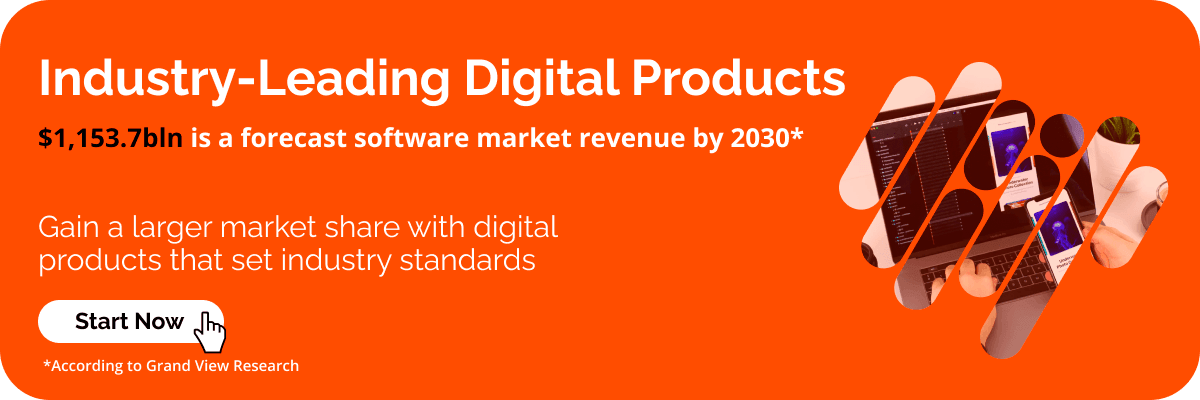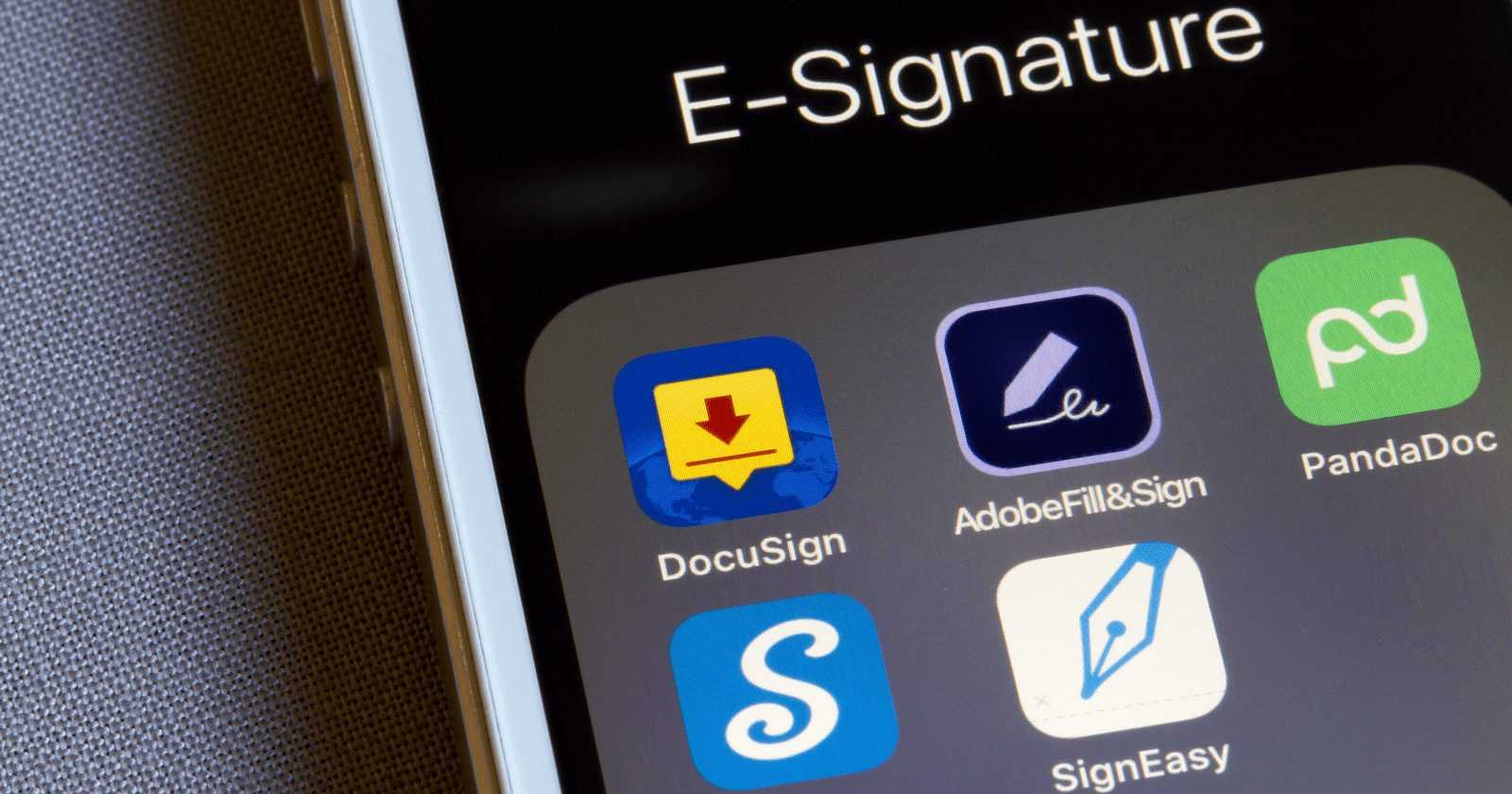The SaaS market is expanding and is predicted to amount to the staggering US $307.3 billion in 2026. There is no exaggeration – cloud-based SaaS development has grown to be a dominant model for software development.
Below, we will uncover the following points:
- SaaS definition, meaning what stands for SaaS products,
- benefits of web-based software as a service,
- existing SaaS app types including the variety of apps in the niche,
- key functionality under software as a service model,
- difficulties that stand in the way of creating SaaS solutions,
- draft a comprehensive strategy for building SaaS services,
- what tech stack and the volume of app development costs involved.
First off though, let’s define software as a service more specifically.
What is SaaS?
SaaS meaning stands for “software as a service”. Put simply:
Software as a service represents cloud-hosted applications accessible via a smartphone or web interface.
The first SaaS apps started getting developed around the beginning of the 21st century. The software tools we use daily, such as Dropbox, Canva, Slack, and Google Docs are, in essence, SaaS platforms.
To see what sets SaaS product apart from conventional software, consider some of these distinct specifics:
- Payment
There is no necessity to purchase a license to use an application on a software-as-a-service basis. Instead, app vendors charge you a regular fee for a full set of its features.
- Access
As the name implies, cloud-based apps are deployed in cloud infrastructure and may be accessed via a web interface or a mobile device.
- Updates
Users don’t need to buy a new SaaS application version every time the product development team introduces updates. The dev team works on app development continuously, with zero impact on user experience.
Why SaaS Development Is So Popular: Market Overview
The adoption of the SaaS model, is, indeed, increasing across industries. Consider these impressive SaaS business stats:
- Global spendings on SaaS R&D equal almost 20% of all corporate R&D in the US.
- The Asia Pacific and North America are leaders in SaaS adoption.
- Salesforce, is the leading SaaS company, with market capital currently exceeding US $243 billion.
- The overall number of players in the global SaaS providers market has reached 30,800 in 2023.
- The market for web-based solutions has been estimated to grow at an 11.7% CAGR from 2020 to 2026.
Organizations’ efforts to keep abreast of digital transformation are the main reasons for embracing SaaS product development. Companies are also finding it highly beneficial for their businesses.
Advantages of SaaS Application Development
Cloud-based SaaS solutions are confidently replacing conventional apps installed on local infrastructures.
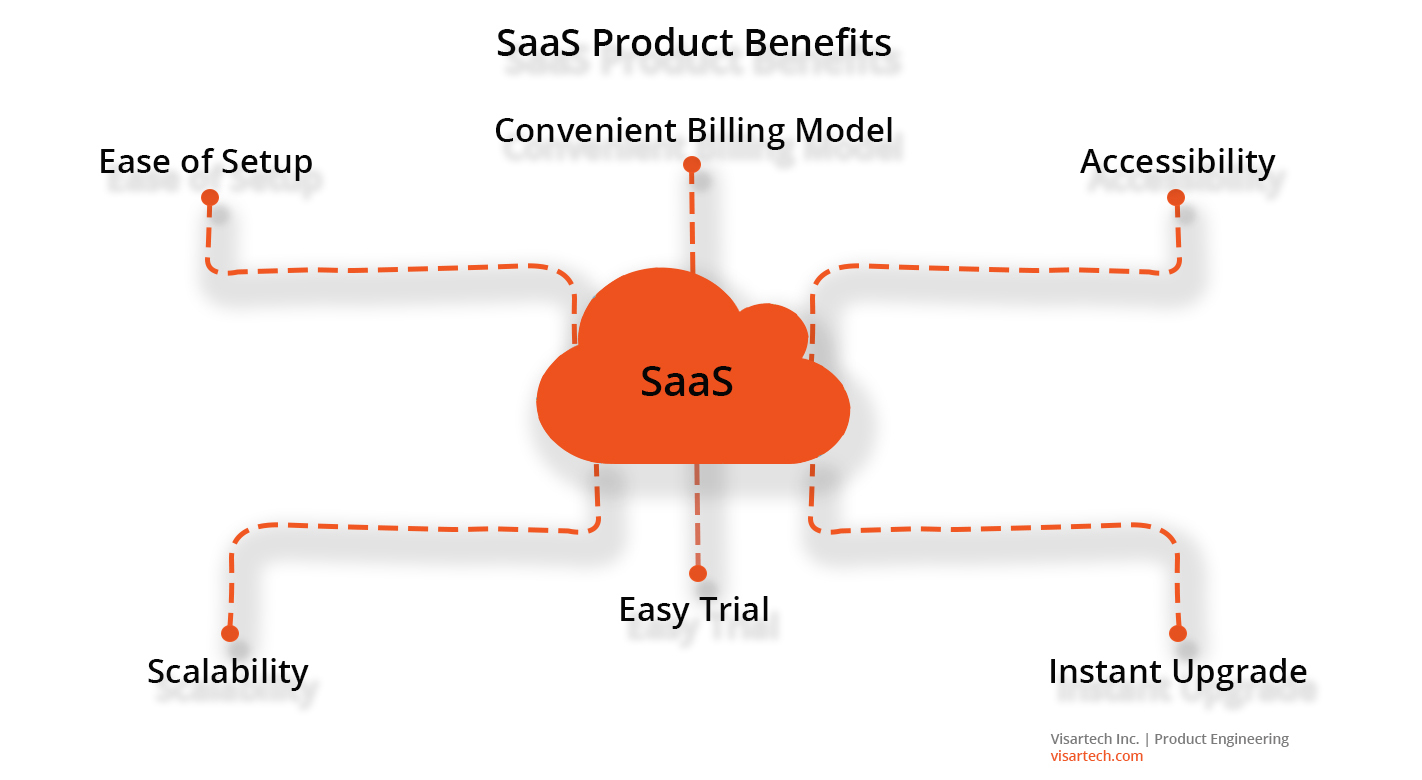
Let’s take a closer look at what companies find beneficial about SaaS products.
Ease of Setup
SaaS apps are web-based, so no complex setup is necessary. Neither do companies have to acquire infrastructure resources in order to run these cloud-based apps.
Scalability
If their business expands, companies can easily scale their SaaS solutions. It allows to handle increasing workloads and accommodate more users. With traditional software running on top of an op-prem infrastructure, scalability often becomes an issue.
Convenient Billing Model
SaaS fees are included in the monthly operational expenses, which is easier for most companies to pay than a costly application license. If the SaaS application scales, the fees increase, but there’s no need to invest in additional infrastructure capacities.
Instant Upgrade
Users get to benefit from SaaS software upgrades as soon as they get deployed. With traditional software, to access improved features and added functionality organizations need to purchase and install a new app version.
Accessibility
Companies can use any SaaS application literally whenever they need and from any location, as long as there’s the Internet. With the work-from-home model likely here to stay, accessibility is becoming a must-have.
Easy Trial
SaaS products allow users to try them before they actually commit. Rather than investing in an application that may not fully live up to expectations, users can test-drive the app features and see if they meet their needs.
Types of SaaS Apps
Numerous kinds of applications are developed as SaaS solutions. The retail and eCommerce sectors are eager adopters of SaaS products. Wix and Shopify page-building platforms are setting the standards for SaaS product management in the eCommerce industry.
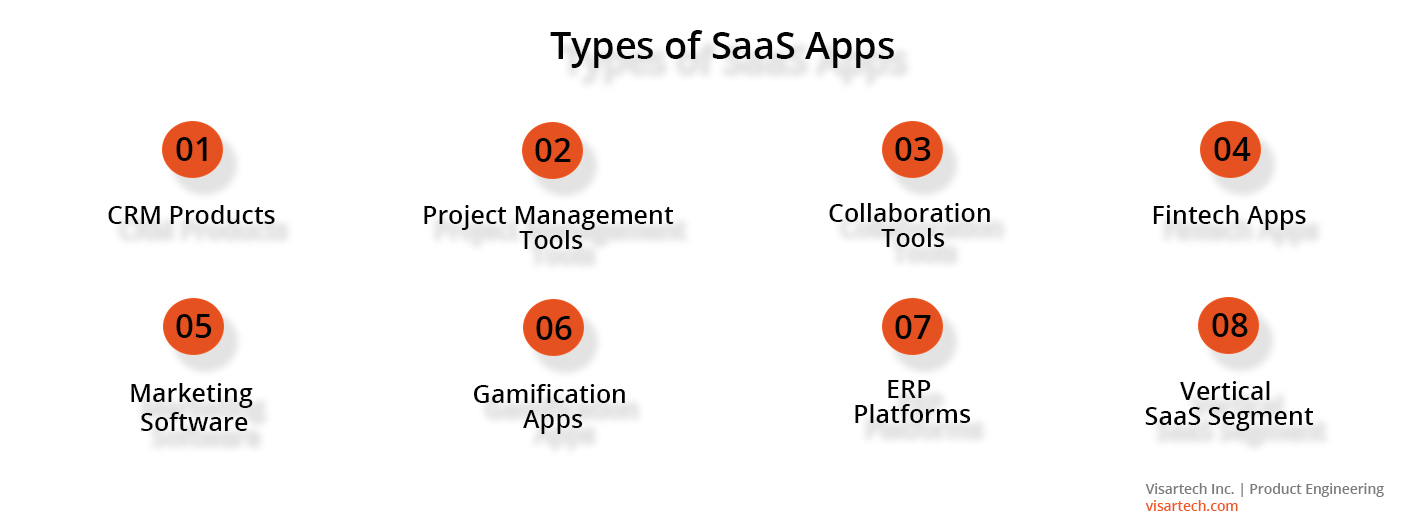
The SaaS offerings, however, are not limited by these categories. Below is an overview of the existing app types in the SaaS product market.
CRM Products
SaaS products for managing interactions with customers help companies keep track of all the customers’ data, automate marketing efforts, provide insights and analytics, forecast future sales, etc. Salesforce, for example, is a leading cloud-based CRM software vendor, but there are numerous other players offering tools for similar purposes.
Project Management Tools
Most companies no longer invest in buying licensed PM software packages. Instead, they use SaaS products like Jira and Monday to manage workflows, assign tasks and track their completion.
Collaboration Tools
For example, such a SaaS product as Slack or Trello combines project management capabilities with collaboration features. The coronavirus lockdown has led to the emergence of web-based video conferencing platforms, such as Zoom, used extensively for both personal and business communication.
Apart from traditional collaboration tools, the new immersive solutions unmistakably stand out. With headsets and access to the Internet, apps like VR сhat or a collaborative platform for business enable users to run in-person meetings in a virtual environment.
Fintech Apps
Today’s cloud computing services also include SaaS products for billing and financial transactions. Cloud-based billing services like Stripe combine merchant accounts with payment gateways and subscription management capabilities.
At Visartech, we have expertise in SaaS application development which includes building finance management web platforms for families. A loan management system helps customers securely transfer money to their loved ones.
Marketing Software
Businesses also use web platforms to create, launch and evaluate promotion campaigns. This is also one of the most densely populated SaaS market segments with platforms like Microsoft Dynamics 365 Marketing among global leaders. Interestingly, while back in 2007 the number of marketing tools hardly reached several hundred, today more than 8 500 apps are assisting in businesses consolidating their marketing efforts.
Gamification Apps
A trend towards boosting productivity via gamification is now gaining momentum. For businesses, looking to maximize their staff engagement, here at Visartech we helped to build a mobile app for increasing productivity. A gamification app for business accounts for 33% growth in employee productivity. This SaaS application comes both in Android and iOS versions.
ERP Platforms
Web-based solutions are also replacing conventional enterprise applications. Robust ERP platforms like SAP feature dashboards and data analytics enabling businesses to gain insights into their operations.
Sports Apps
Coupled with extended reality technologies, cloud-based sports simulation platforms, such as SkyTrak are prominent examples of how SaaS development can benefit sports enthusiasts. This SaaS software enables users to hone their golf skills and play real-time games in a virtual environment.
Vertical SaaS Segment
These SaaS product types are specific to a particular business segment. There are web services, targeting construction, HORECA, insurance, manufacturing, and other industries. Veeva, for instance, is a tool for pharma companies enabling them to streamline their operations. Fleetmatics is a SaaS platform for logistics.
Here at Visartech, we have delivered a range of SaaS solutions for the E-learning industry. It includes full-scale digital ecosystems like e-learning platforms for schools and interactive 3D models for colleges equipped with virtual classrooms and course authoring tools. Not to mention, gamification apps for younger kids such as a learn-to-read gamified app.
By contrast, horizontal apps like Asana can serve companies across a number of industries. Dropbox storage service is also an example of a horizontal SaaS app, suitable for individual and business use.
Key Features To Consider While Creating SaaS Applications
As diverse as they may be, SaaS products share some of the essential specifics. If you are planning to build SaaS platforms, here’s a checklist of the main requirements to consider.
- Functional Features
These features will become your users’ primary reason for using your software product. Zoom, for instance, helps users create and manage a video-conferencing environment. While Canva enables them to create compelling graphics using customizable templates.
- Data Analytics
One of the hottest web development trends is integrating analytics tools into SaaS solutions. In the vertical SaaS segment, numerous reports and dashboards help customers gain insights about the success of their business efforts, current trends, etc. Retailers, for instance, may use analytics to track user behavior patterns and measure the success of their marketing campaigns.
- Tools for Managing User Roles
The SaaS solution may have different access layers, so it may be necessary to introduce tools for managing user roles. In Clubhouse, for example, users may act as Listeners, Speakers, or Moderators, and the user roles are very distinct.
8 Steps for Building Software-as-a-Service Apps from Scratch
As such, SaaS product development is a complex process that requires a clear product roadmap with several logical steps.
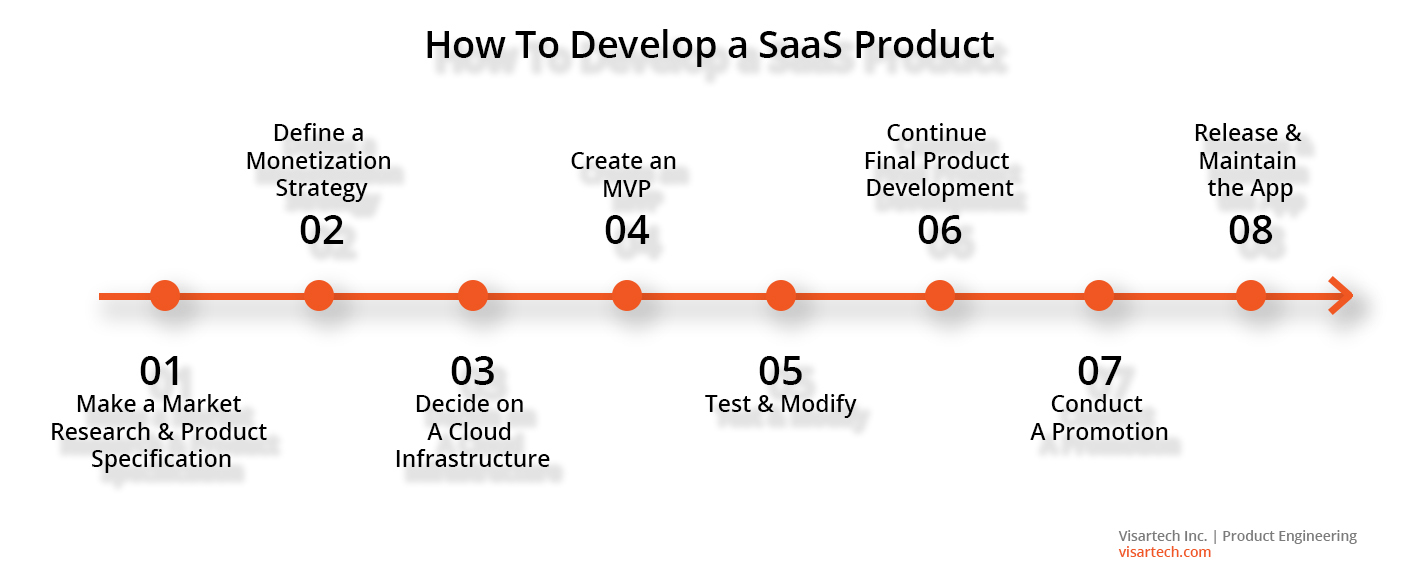
Below we will guide you through the SaaS product development process. There you will clearly see the step-by-step roadmap implementation of building cloud-based apps.
Step #1. Research and Create App Tech Specification
Your goal at this point is to collect as much information as possible about your future customers, competitors, trends, and emerging technologies. Combined with information about the shortcomings of competitors’ apps, insights into users’ needs will enable you to come up with a truly unique SaaS product. If you’re contemplating building vertical SaaS business applications, study the developing tendencies in the industry you will be tapping into.
Read also: How Tech Consulting Firm Can Grow Your Business
Learn about tech consulting benefits, implementation & costs
At the end of the initial phase of the app development process, you will create a detailed and exhaustive technical specification containing your app’s functional and non-functional requirements and guidelines for product development. It may be the first step to your SaaS MVP development.
Step #2. Define Revenue Channels
How exactly do you intend to earn money with your SaaS solution? It is essential to answer this question before you embark on a full-scale software development project. This is one of the crucial steps for building SaaS apps since it will determine the structure of your software product – something that can’t easily be undone, so think carefully.
The most widely spread ways to generate income include advertising, subscription, and freemium models. If you will be building a cloud-based marketplace, consider introducing transaction and/or selling fees.
Step #3. Decide on a Cloud Infrastructure Provider
To serve multiple users while securing their data, you need to select a proper cloud infrastructure company. Go for the proven and reputable vendors, capable of maintaining the best encryption and data center security practices. Your SaaS platform will run on cloud infrastructure, so choose the cloud service provider that will deliver an excellent level of scalability, reliability, and performance, capable of supporting third-party integrations.
Step #4. Create an MVP
This isn’t a full-fledged cloud-based solution just yet. Minimum Viable Product (MVP) is a trial application version with only the basic feature set. Deciding which features you will include in your MVP will require planning, though. Implement the features that will have the most impact while being the least financially expensive. Your goal at this point is to convince your investors.
Step #5. Test and Implement Changes
After you release an MVP, collect feedback. The best way to do it is to ask users directly what they like or dislike about your product. At this point, making changes to an app feature set or architecture will be relatively easy and not as painstaking as during further steps. The target group you choose for proof-of-concept testing could later become early adopters of your app.
Step #6. Start the End Product Development
This is the phase when your app development team starts coding, using the chosen programming language, toolsets, and frameworks. The use of agile methodologies like Scrum, Kanban, or Extreme Programming, will streamline and accelerate the development while sticking to the specification guidelines and ensuring quality.
Today’s best practices suggest integrating QA testing into every stage of software development. Also, stay in contact with your dedicated development team over the course of implementing your SaaS app idea. Your goal is to constantly check if you stay on the same page and are correctly following product specifications.
Step #7. Promotion
We are listing promotion as a separate step, while in reality, it should unfold simultaneously with building your SaaS app. By the time your first release hits the web stores, you should already have a community of fans waiting for the final version.
Step #8. Release and Maintenance
Your SaaS platform or web service is ready for release as soon as you have completed all phases of QA testing. However, you’re not fully done with QA just yet: user acceptance testing will be the final stage of the quality assurance process and will take place after you publish your app.
After the final release, your SaaS developers will have to provide ongoing maintenance and application updates. Your users should be able to easily access tech support if issues arise.
Tech Difficulties of Creating a Saas Application
The above software development steps are smooth and consistent. Yet, they by no means eliminate the tech difficulties. The common challenges in cloud-based apps development include:
- Multi-Tenancy
The software you build will serve multiple customers. Regardless of the kinds of applications developed, cloud-based SaaS architecture should include multi-tenancy. You will also have to impose measures preventing customers (tenants) from accessing other customers’ data.
- Customization
When building SaaS apps for different types of businesses and user categories, think about making them flexible and configurable for different user needs from the very start. Users should be able to customize the app for a maximum personalized experience. Additionally, consider enhancing user engagement by embedding a social media feed, fostering a more dynamic and interactive user interface.
- Scalability
The web application you build should scale on-demand to accommodate more users or increase workloads – preferably with zero outages and disruptions. Top-notch scalability is a must for enterprises that can afford zero downtime.
- Connectability
The app you build should include APIs enabling any third-party developer to connect it to any other platform or service used by the organization. Your SaaS platform is likely to be used with other apps and systems, so it’s important to include connectivity into its architecture as you start development.
Ensuring scalability, security, and integration in a cloud environment is a tricky task, so do approach a choice of a cloud infrastructure provider carefully and responsibly.
Apart from a cloud provider, it is also recommended to approach the choice of your tech stack with the utmost consideration.
The Perfect Tech Stack for SaaS Development
Picking the best technologies is an essential procedure. According to the current web development trends, technologies commonly used in SaaS development are as follows:
- Frontend
Front-end developers work with languages like HTML, Javascript, and CSS, and frameworks like Angular and React, and build a web app.
- Backend
When choosing a programming language, your scope is pretty much narrowed down to Python, PHP, JavaScript, and their native development environments.
- Backend storage
Consider MySQL, MongoDB, or PostgreSQL when choosing a perfect database for storage management.
The choice of servers is also limited to either Apache or Nginx.
Read also: How to Save Money on a Web Project for Businesses
Learn how to select the best tech stack for your web application
Ultimately, your unique application’s specifics will determine your choice of technologies.
Costs to Build a SaaS Application
Software development involves expenses, and building cloud-based platforms and services are no exception. To estimate how much exactly it will cost to build a SaaS app, consider its complexity and the hourly rates of your SaaS developers.
Read also: How Much Does It Cost To Create an App?
Check out the comprehensive guide on app development cost
Put simply, the more features your product includes, the more time it will take to implement them.
To create apps as complex as Slack, developers will have to allocate over 2600 hours of work, including iOS, Android, and UI/UX development. So the development time may take more than a year.
Based on the information from such platforms as Clutch or GoodFirms, the average development hourly rates fall into the range of $50 to $120. This, in turn, reflects in the total development cost of a Slack-like app: $130,000 – $312,000.
Of course, the final calculation will also depend on the qualification of the developers involved in your project. The junior developer’s rate will be considerably lower than that of a senior developer.
How to Find a Development Team For SaaS Project
If you’re looking to hire SaaS developers, you have three options:
- Looking for freelancers at global marketplaces like Upwork.
- Hiring internal employees to develop a SaaS application.
- Partnering with product development companies.
These options have both pros and cons:
- Freelancers
While freelancers may charge less, their expertise and loyalty are questionable and hardly suitable for building a product that needs regular maintenance and updates.
- In-house developers
An internal team gives you confidence and reassurance when it comes to product support and the integrity of the intellectual property. On the downside, the tech expert salaries in the developed economies are notoriously high, not to mention compensation packages, rental of office spaces, taxes, etc.
- Product development companies
Partnering with product development companies, on the other hand, gives you access to global talent pools, and a choice of collaboration models – from full-scale project outsourcing to extending your team to bridge the skills gap.
Conclusions
The SaaS development looks highly attractive for both companies and individuals: ease of entry, flexible pricing, and excellent accessibility make users choose web-based tools and services over traditional software. The prospects of building cloud-based solutions look brighter than ever, yet, there are many challenges and pitfalls associated with web app development.
One of these challenges is the heightened demand for relevant high-tech expertise. To build cloud-based services and platforms, you need an app development team proficient in web development and experience in creating cloud-based solutions. To strike a delicate balance between pricing and quality, consider hiring a reliable external SaaS development company to help you build a SaaS product that fully meets your business objectives.
Interested in SaaS app development? Connect with our experts now to schedule a free chat!

